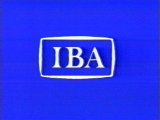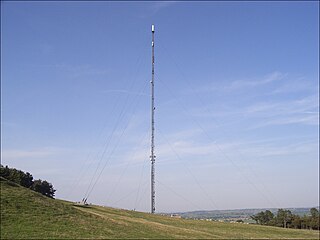
Channel 4 is a British free-to-air public broadcast television channel owned and operated by the state-owned Channel Four Television Corporation. It is publicly owned but, unlike the BBC, it receives no public funding and is instead funded entirely by its own commercial activities, including publicity. It began its transmission in 1982 and was established to provide a fourth television service in the United Kingdom. At the time, the only other channels were the licence-funded BBC One and BBC Two, and a single commercial broadcasting network ITV.

ITV is a British free-to-air public broadcast television network. It was launched in 1955 as Independent Television to provide competition and reduce the current monopoly to the then BBC Television. ITV is the oldest commercial network in the UK. Since the passing of the Broadcasting Act 1990, it has been legally known as Channel 3 to distinguish it from the other analogue channels at the time: BBC One, BBC Two, and Channel 4.

Freeview is the United Kingdom's sole digital terrestrial television platform. It is operated by Everyone TV and DTV Services Ltd, a joint venture between the BBC, ITV, Channel 4, Channel 5 and Sky. It was launched on 30 October 2002, taking over the licence from ITV Digital which collapsed that year. The service provides consumer access via an aerial to the seven DTT multiplexes covering the United Kingdom. As of July 2020, it has 85 TV channels, 26 digital radio channels, 10 HD channels, six text services, 11 streamed channels, and one interactive channel.
Regular television broadcasts in the United Kingdom started in 1936 as a public service which was free of advertising, which followed the first demonstration of a transmitted moving image in 1926. Currently, the United Kingdom has a collection of free-to-air, free-to-view and subscription services over a variety of distribution media, through which there are over 480 channels for consumers as well as on-demand content. There are six main channel owners who are responsible for most material viewed.

The Office of Communications, commonly known as Ofcom, is the government-approved regulatory and competition authority for the broadcasting, telecommunications and postal industries of the United Kingdom.
Teletext Ltd was the provider of teletext and digital interactive services for ITV, Channel 4 and Five in the United Kingdom.

The Independent Broadcasting Authority (IBA) was the regulatory body in the United Kingdom for commercial television – and commercial and independent radio broadcasts. The IBA came into being when the Sound Broadcasting Act 1972 gave the Independent Television Authority responsibility for organising the new Independent Local Radio (ILR) stations. The Independent Television Commission formally replaced the IBA on 1 January 1991 in regulatory terms; however, the authority itself was not officially dissolved until 2003.

The Crystal Palace transmitting station, officially known as Arqiva Crystal Palace, is a broadcasting and telecommunications site in the Crystal Palace area of the London Borough of Bromley, England. It is located on the site of the former television station and transmitter operated by John Logie Baird from 1933.
United Kingdom Independent Broadcasting (UKIB) is an affiliation of three British independent television production companies and broadcasters. The primary function of its predecessor, the Independent Television Companies Association (ITCA), was to represent independent British television interests as a member of the European Broadcasting Union (EBU). The current members of UKIB are the ITV network centre, the 4 ITV licence holders, Channel 4, and S4C.
Religious broadcasting, sometimes referred to as faith-based broadcasts, is the dissemination of television and/or radio content that intentionally has religious ideas, religious experience, or religious practice as its core focus. In some countries, religious broadcasting developed primarily within the context of public service provision, whilst in others, it has been driven more by religious organisations themselves. Across Europe and in the US and Canada, religious broadcasting began in the earliest days of radio, usually with the transmission of religious worship, preaching or "talks". Over time, formats evolved to include a broad range of styles and approaches, including radio and television drama, documentary, and chat show formats, as well as more traditional devotional content. Today, many religious organizations record sermons and lectures, and have moved into distributing content on their own web-based IP channels.
There are several different types of mass media in the United Kingdom: television, radio, newspapers, magazines and websites. The United Kingdom is known for its large music industry, along with its new and upcoming artists. The country also has a large broadcasting, film, video games and book publishing industries.
Digital terrestrial television in the United Kingdom encompasses over 100 television, radio and interactive services broadcast via the United Kingdom's terrestrial television network and receivable with a standard television set. The majority of digital terrestrial television (DTT) services, including the five former analogue channels, are broadcast free-to-air, and a further selection of encrypted pay TV services are also available.

Channel Four Television Corporation is a British state-owned media company which runs 12 channels and a streaming service. Unlike the BBC, it receives no public funding and is instead funded entirely by its own commercial activities. Its original and principal activity is the British national television network Channel 4.

The Moel-y-Parc transmitting station is situated on Moel y Parc, a hill in north-east Wales at the northern end of the Clwydian range, close to the town of Caerwys and several miles (kilometres) north-east of Denbigh. It was built in 1962/1963 by the IBA to bring 405-line VHF ITV television to North Wales and it has been on the air since 1963. Its original height of 229 metres (751 ft) made it the tallest structure in North Wales and it stands on land that is itself about 335 metres (1,099 ft) above sea level. In 1965, VHF television transmissions from the BBC commenced from the site.
Analogue terrestrial television in the United Kingdom was originally the method by which the significant majority of viewers in the UK, the Channel Islands and the Isle of Man received television. Analogue terrestrial television broadcasts have fully ceased in the UK with Northern Ireland being the last region to have ceased transmission analogue terrestrial television broadcasts. Northern Ireland switched off the last analogue television signals, making all of the United Kingdom only capable of receiving digital television, in the early hours of 24 October, 2012. It has been completely replaced by digital terrestrial television and other non-terrestrial means as of the end of 2012.
There are four major forms of digital television (DTV) broadcast in the United Kingdom: a direct-to-home satellite service from the Astra 28.2°E satellites provided by Sky UK, a cable television service provided by Virgin Media ; a free-to-air satellite service called Freesat; and a free-to-air digital terrestrial service called Freeview. In addition, an IPTV system known as BT TV is provided by BT. Individual access methods vary throughout the country. 77% of the United Kingdom has access to HDTV via terrestrial digital television. Satellite is the only source of HDTV broadcast available for the remaining 23%.
The media in Northern Ireland are closely linked to those in the rest of the United Kingdom, and also overlap with print, television, and radio in the Republic of Ireland.
High-definition television in the United Kingdom is available via cable, IPTV, satellite and terrestrial television. The first high-definition broadcasts began in late 2005 and since then the number of channels available to view has grown to a maximum of 87 that can be viewed on pay-TV service, Sky.

Television in Wales began in 1952. Initially, all programmes were in English with occasional Welsh language programmes. In 1982 Welsh language channel S4C was launched. The digital switchover happened in 2009-2010 and S4C became an exclusively Welsh language channel.








